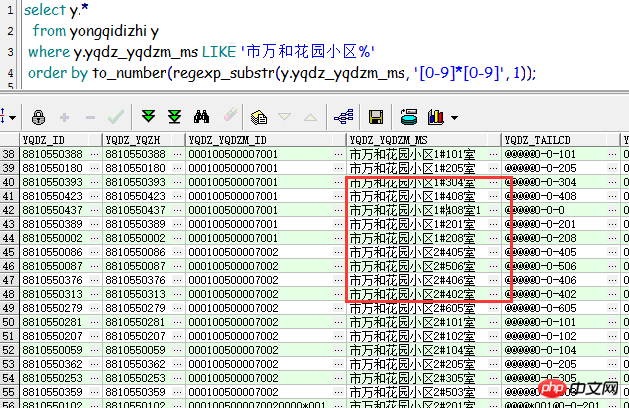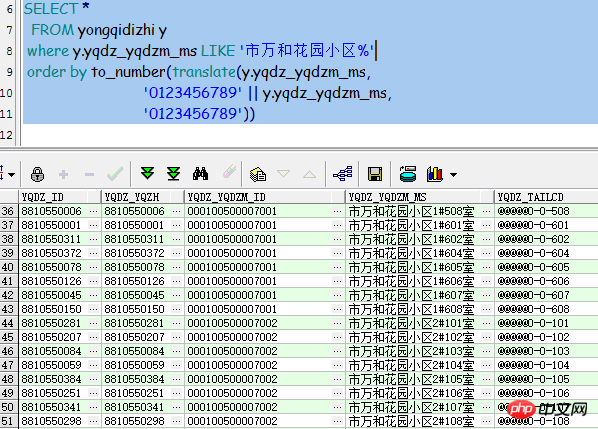 Database
Database
 Mysql Tutorial
Mysql Tutorial
 Solving the sorting problem of Oracle strings containing numbers and special symbols
Solving the sorting problem of Oracle strings containing numbers and special symbols
Solving the sorting problem of Oracle strings containing numbers and special symbols
This article will share with you how to solve the sorting problem that contains numbers and special symbols in Oracle strings. Recently, I encountered such a demand in a project, which required that a certain community be sorted according to community, building, unit number, and room number. It seems to be a very simple requirement that can be solved with a SQL statement. In fact, the routine is very deep. Below, I will share with you the sorting problem of numbers and special symbols in Oracle strings. I hope it can help you.
Problem description:
In a certain community, it is necessary to sort by community, building, unit number, and room number, but it is sorted by address description. At this time, because the string contains numbers, the following results are produced. Building No. 1 should be followed by Building No. 2, but the query result is Building No. 10.
 Try to solve
Try to solve
Use regular expression to replace
## Result: 
You can find that the results are displayed normally. 
1. Grammar:
TRANSLATE (string,from_str,to_str)
2. Purpose
Return to replace each character in (all occurrences) from_str with the corresponding character in to_str The string after the characters. TRANSLATE is a superset of the functionality provided by REPLACE. If from_str is longer than to_str, the extra characters in from_str but not in to_str will be removed from string because they have no corresponding replacement characters. to_str cannot be empty. Oracle interprets empty strings as NULL, and if any parameter in TRANSLATE is NULL, the result is NULL.
3. Allowed locations
Procedural statements and SQL statements.
4. Example
Sql code
SELECT TRANSLATE('abcdefghij','abcdef','123456') FROM dual; TRANSLATE ( -------------- 123456ghij SELECT TRANSLATE('abcdefghij','abcdefghij','123456') FROM dual; TRANSL ---------- 123456
ANSLATE( expr,from,to)
expr: represents a string of characters, from and to have a one-to-one correspondence from left to right. If they cannot correspond, they are regarded as null values.
select translate('abcbbaadef','ba','#@') from dual (b将被#替代,a将被@替代) select translate('abcbbaadef','bad','#@') from dual (b将被#替代,a将被@替代,d对应的值是空值,将被移走)
TRANSLATE(expr,from,to)
expr: represents a string of characters, from and to have a one-to-one correspondence from left to right, If it cannot correspond, it is regarded as a null value.
select translate('abcbbaadef','ba','#@') from dual (b将被#替代,a将被@替代) select translate('abcbbaadef','bad','#@') from dual (b将被#替代,a将被@替代,d对应的值是空值,将被移走)
SELECT TRANSLATE('2KRW229','0123456789ABCDEFGHIJKLMNOPQRSTUVWXYZ','9999999999XXXXXXXXXXXXXXXXXXXXXXXXXX') "License"FROM DUAL
SELECT TRANSLATE('2KRW229','0123456789ABCDEFGHIJKLMNOPQRSTUVWXYZ','0123456789') "Translate example"FROM DUAL
SELECT TRANSLATE('我是中国人,我爱中国', '中国', 'China') "Translate example" FROM DUAL
SELECT TRANSLATE('I am Chinese, I love China', 'China', '中国') "Translate example" FROM DUAL
SELECT TRANSLATE('2KRW229', '0123456789ABCDEFGHIJKLMNOPQRSTUVWXYZ', '') "License" FROM DUAL
SELECT TRANSLATE('中国人', substr('中国人',1,length('中国人') - 1), rpad('*',length('中国人'),'*')) "License" FROM DUAL
Related recommendations:
About the usage summary of Contains function in Oracle
Detailed explanation of the basic principles of Oracle paging query
Oracle program development tips
The above is the detailed content of Solving the sorting problem of Oracle strings containing numbers and special symbols. For more information, please follow other related articles on the PHP Chinese website!

Hot AI Tools

Undresser.AI Undress
AI-powered app for creating realistic nude photos

AI Clothes Remover
Online AI tool for removing clothes from photos.

Undress AI Tool
Undress images for free

Clothoff.io
AI clothes remover

Video Face Swap
Swap faces in any video effortlessly with our completely free AI face swap tool!

Hot Article

Hot Tools

Notepad++7.3.1
Easy-to-use and free code editor

SublimeText3 Chinese version
Chinese version, very easy to use

Zend Studio 13.0.1
Powerful PHP integrated development environment

Dreamweaver CS6
Visual web development tools

SublimeText3 Mac version
God-level code editing software (SublimeText3)

Hot Topics
 1657
1657
 14
14
 1415
1415
 52
52
 1309
1309
 25
25
 1257
1257
 29
29
 1230
1230
 24
24
 What to do if the oracle can't be opened
Apr 11, 2025 pm 10:06 PM
What to do if the oracle can't be opened
Apr 11, 2025 pm 10:06 PM
Solutions to Oracle cannot be opened include: 1. Start the database service; 2. Start the listener; 3. Check port conflicts; 4. Set environment variables correctly; 5. Make sure the firewall or antivirus software does not block the connection; 6. Check whether the server is closed; 7. Use RMAN to recover corrupt files; 8. Check whether the TNS service name is correct; 9. Check network connection; 10. Reinstall Oracle software.
 How to solve the problem of closing oracle cursor
Apr 11, 2025 pm 10:18 PM
How to solve the problem of closing oracle cursor
Apr 11, 2025 pm 10:18 PM
The method to solve the Oracle cursor closure problem includes: explicitly closing the cursor using the CLOSE statement. Declare the cursor in the FOR UPDATE clause so that it automatically closes after the scope is ended. Declare the cursor in the USING clause so that it automatically closes when the associated PL/SQL variable is closed. Use exception handling to ensure that the cursor is closed in any exception situation. Use the connection pool to automatically close the cursor. Disable automatic submission and delay cursor closing.
 How to create cursors in oracle loop
Apr 12, 2025 am 06:18 AM
How to create cursors in oracle loop
Apr 12, 2025 am 06:18 AM
In Oracle, the FOR LOOP loop can create cursors dynamically. The steps are: 1. Define the cursor type; 2. Create the loop; 3. Create the cursor dynamically; 4. Execute the cursor; 5. Close the cursor. Example: A cursor can be created cycle-by-circuit to display the names and salaries of the top 10 employees.
 What to do if the oracle log is full
Apr 12, 2025 am 06:09 AM
What to do if the oracle log is full
Apr 12, 2025 am 06:09 AM
When Oracle log files are full, the following solutions can be adopted: 1) Clean old log files; 2) Increase the log file size; 3) Increase the log file group; 4) Set up automatic log management; 5) Reinitialize the database. Before implementing any solution, it is recommended to back up the database to prevent data loss.
 Oracle's Role in the Business World
Apr 23, 2025 am 12:01 AM
Oracle's Role in the Business World
Apr 23, 2025 am 12:01 AM
Oracle is not only a database company, but also a leader in cloud computing and ERP systems. 1. Oracle provides comprehensive solutions from database to cloud services and ERP systems. 2. OracleCloud challenges AWS and Azure, providing IaaS, PaaS and SaaS services. 3. Oracle's ERP systems such as E-BusinessSuite and FusionApplications help enterprises optimize operations.
 What steps are required to configure CentOS in HDFS
Apr 14, 2025 pm 06:42 PM
What steps are required to configure CentOS in HDFS
Apr 14, 2025 pm 06:42 PM
Building a Hadoop Distributed File System (HDFS) on a CentOS system requires multiple steps. This article provides a brief configuration guide. 1. Prepare to install JDK in the early stage: Install JavaDevelopmentKit (JDK) on all nodes, and the version must be compatible with Hadoop. The installation package can be downloaded from the Oracle official website. Environment variable configuration: Edit /etc/profile file, set Java and Hadoop environment variables, so that the system can find the installation path of JDK and Hadoop. 2. Security configuration: SSH password-free login to generate SSH key: Use the ssh-keygen command on each node
 How to stop oracle database
Apr 12, 2025 am 06:12 AM
How to stop oracle database
Apr 12, 2025 am 06:12 AM
To stop an Oracle database, perform the following steps: 1. Connect to the database; 2. Shutdown immediately; 3. Shutdown abort completely.
 How to create oracle dynamic sql
Apr 12, 2025 am 06:06 AM
How to create oracle dynamic sql
Apr 12, 2025 am 06:06 AM
SQL statements can be created and executed based on runtime input by using Oracle's dynamic SQL. The steps include: preparing an empty string variable to store dynamically generated SQL statements. Use the EXECUTE IMMEDIATE or PREPARE statement to compile and execute dynamic SQL statements. Use bind variable to pass user input or other dynamic values to dynamic SQL. Use EXECUTE IMMEDIATE or EXECUTE to execute dynamic SQL statements.



